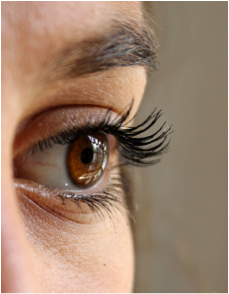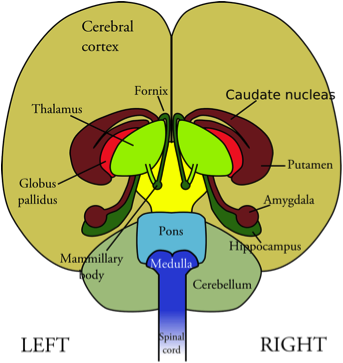|
| |
Part II on Brain Myths: Are We Really Right-or Left-Brained Dominant?Patrick T. Randolph, Western Michigan University 
This article is the seventh in a multi-article series based on “What Every Teacher Needs to Know About the Brain,” a presentation given at the 2013 ITBE Convention in Lisle, IL. Introduction It is surprising just how many brain myths get tossed about and used as facts for marketing devices. Consider the trailer for last summer’s French-American science-fiction film, Lucy; it perpetuated the common myth that we use only 10% of our brain. Then, there is the famous 1979 art book (now in its 4th edition), Drawing on the Right Side of the Brain, by Betty Edwards. Do we really use just one side or the other of the brain while drawing? Part II of these common brain myths takes a look at the supposed right- and left-brain distinction, examines the number of senses we have, and investigates the belief that Mozart’s music can increase our intelligence. Picking up where we left off in the previous article (see The ITBE Link, V42, N2, Myths 1-3), we start here with Brain Myth #4. Brain Myth #4: We are either right- or left-brained dominant. Brain Fact: “In reality, we are all whole-brain users.” —Amy Shelton, PhD A chapter in Creative Journal Writing, by Stephanie Dowrick, starts with the following paragraph: Journal writing develops both your so-called right-brain strengths (lateral problem solving, intuitive, creative, emotional) and your so-called left-brain strengths (intellectual, sequential, national, orderly). (2009, p. 27)
While Dowrick does qualify her claim with the use of “so-called” in defining the right- and left-brain “strengths,” she nevertheless uses them and goes on to further the myth by laying out each hemisphere’s “strengths.” And although (as far as we currently know) it is true that the left hemisphere houses much of our language abilities and the right is responsible for more creative functions and spatial oriented analyses, the truth is, according to Amy Shelton of Johns Hopkins University, “we are all whole-brain users” (as sited in Wallace, 2014, para. 7). We must remember that although there are two hemispheres, the four lobes (the frontal, parietal, temporal, and occipital) work continually and constantly in both hemispheres. Moreover, each hemisphere has a hippocampus and an amygdala—two essential members of the limbic system that promote learning, memory, and intellectual development. In short, we are “whole-brain users” and not right- or left-brained dominant. And, as Wallace (2014) has pointed out, “a mountain of research and thousands of brain scans have proven that we use both sides of our brain equally” (para. 8). What this means for us in the ELL classroom: The most significant thing we can do is make our students and colleagues aware that this right- and left-brain distinction is nothing more than a myth and explain that it is more of a hindrance than a help. If we continue to perpetuate the myth, we will only create an illusion of meaningless categories. And second, we must continue to be as creative as possible and promote the functions and uses of all regions of the brain. Two of the best tools that seem to be supported by neuroscience (Jensen, 2008; Medina, 2009; Sousa, 2011) are the use of the emotions and multisensory activities. These help in working the whole brain and dismiss the ghost of right- and left-brain dominance.  Source: www.pixabay.com Brain Myth #5: We have five senses. Brain Fact: We have at least 10, but we could have many more (Ward, 2008). Aristotle, the great Greek philosopher and categorizer, set in stone the idea that we have five senses, which, of course, is true. There is no denying we have the faculties of hearing, smell, taste, touch, and vision. I have included the five senses as a myth, though, because we seem to think that’s all we have. The truth is, however, we have many more (Helmuth, 2011). In addition to the five listed above, we also have senses for pain, temperature, balance, proprioception (this includes how we position our bodies), and interoception (this includes feeling internal realities like hunger); and, as Ward (2008) has noted, the 2005 winter issue of New Scientist claims that there might be as many as 33 senses. What this means for us in the ELL classroom: Research done in neuroscience and experiments conducted in marketing have shown that exposure to multisensory environments leads to intriguing consequences—both in terms of deeper learning and in terms of increased sales (Medina, 2009). It follows then that the more senses we can use in the classroom, the more our students will learn the material, and the more concepts and skills they can transfer from their working- to their long-term memory. The fact that we have 10 or more senses gives us a wonderful opportunity to tap into their resources for long-term learning and an increased interest in how that learning is done. For example, when I teach vocabulary items using my Head-to-Toe Method of Associations for Vocabulary Acquisition, I ask my students to associate a smell with each vocabulary term, and I ask them to create a gesture or use body language to represent the definition of each item. In doing so, I help elicit their sense of smell and proprioception and consequently connect these senses to the terms being studied.  Source: www.pixabay.com Brain Myth #6: Listening to Mozart’s music enhances our intelligence. Brain Fact: “Learning to play a musical instrument improves cognitive skills.” —Jessica Grahn, PhD Most would agree that listening to Mozart is indeed a very pleasurable and powerful pastime. But can it actually make us more intelligent? The answer is “yes” if you consider imagining how folded and cut pieces of paper would look like when they are unfolded—that is the extent to which it can make us smarter (Hammond, 2013). In 1993, an experiment was conducted at the University of California, Irvine. Thirty-six young adults participated in performing various cognitive activities. Before they did each task, one being the folded paper activity mentioned above, they listened to (1) silence for 10 minutes, (2) relaxation instructions for 10 minutes, or (3) Mozart for 10 minutes. The students exposed to Mozart’s music performed better on the spatial paper test. This effect, however, only lasted for 15 minutes, then the ability to imagine the spatial representations of the folded paper wore off (Rausher, Shaw, & Ky, 1993). What is intriguing is that in 2006 a similar experiment was conducted in Britain. In this experiment, the participants (8,000 children), like the earlier experiment, had to predict the shapes of paper. This time, however, it was pop music that helped the children in their predictions—not Mozart (Hammond, 2013). In short, Mozart’s music does not necessarily make us more intelligent. What this means for us in the ELL classroom: Perhaps, then, it’s not the kind of music that motivates us to perform better, but rather, it is the personal preference that enhances our productivity and scholarly motivation (Hammond, 2013). So, if we simply want to motivate our students and inspire them to learn, we could easily turn on their preferred music in the classroom. In this sense, if it is music which inspires us to learn, then all music, not just Mozart, could theoretically make us more intelligent. Concluding Remarks Brain myths are certainly influential tools for marketing—whether they are used for promoting a movie or selling educational software. The problem is, these brain myths are just that—myths. They are interesting ideas perpetuated by popular culture that harm rather than help in the sense they limit and prevent our understanding of the brain and how it works. The purpose of exposing these brain myths—like those exposed in the last article—is to break down these falsehoods and help teachers help their students develop their skills at a whole new level. Correspondence concerning this article can be addressed to patricktrandolph@yahoo.com. Patrick T. Randolph currently teaches at Western Michigan University where he specializes in creative and academic writing, speech, and debate. References Dowrick, S. (2009). Creative journal writing: The art and heart of reflection. New York, NY: Tarcher/Penguin. Hammond, C. (2013, January 8). Does listening to Mozart really boost your brainpower? Retrieved from http://www.bbc.com/future/story/20130107-can-mozart-boost-brainpower Helmuth, L. (2011, May 19). Top ten myths about the brain. Retrieved from http://www.smithsonianmay.com Jensen, E. (2008). Brain-based learning: The new paradigm of teaching. Thousand Oaks, CA: Corwin Press. Medina, J. (2009). Brain rules. Seattle, WA: Pear Press. Rauschen, F. H., Shaw, G. L., & Ky, K. N. (1993). Music and spatial task performance. Nature, 365, 611. Sousa, D. A. (2011). How the brain learns. Thousand Oaks, CA: Corwin, A Sage Company. Wallace, R. (2014, July 29). 5 brain myths that won’t go away. Yahoo! Health. Retrieved from https://www.yahoo.com/health/5-brain-myths-that-wont-go-away-92839871807.html Ward, J. (2008). The frog who croaked blue. New York, NY: Routledge. *Photo Credit: Kelly Cunningham | |
| ITBE Link - Winter 2015 - Volume 42 Number 4 |
